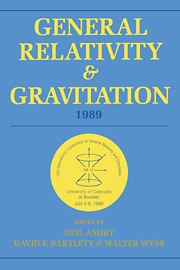 General Relativity and Gravitation, 1989
General Relativity and Gravitation, 1989 Book contents
- Frontmatter
- Contents
- Preface
- Conference committees
- Part A Classical relativity and gravitation theory
- WORKSHOPS
- Part B Relativistic astrophysics, early universe, and classical cosmology
- WORKSHOPS
- Part C Experimental gravitation and gravitational wave detection
- WORKSHOPS
- Part D Quantum gravity, superstrings, quantum cosmology
- WORKSHOPS
- D1 Theories of quantum gravity I (superstring theory)
- D2 New Hamiltonian variables
- D3 Quantum cosmology and baby universes
- D4 Quantum field theory in curved spacetime
- D5 Theories of quantum gravity II (not superstring theory)
- Part E Overviews-past, present, and future
D4 - Quantum field theory in curved spacetime
Published online by Cambridge University Press: 05 March 2012
- Frontmatter
- Contents
- Preface
- Conference committees
- Part A Classical relativity and gravitation theory
- WORKSHOPS
- Part B Relativistic astrophysics, early universe, and classical cosmology
- WORKSHOPS
- Part C Experimental gravitation and gravitational wave detection
- WORKSHOPS
- Part D Quantum gravity, superstrings, quantum cosmology
- WORKSHOPS
- D1 Theories of quantum gravity I (superstring theory)
- D2 New Hamiltonian variables
- D3 Quantum cosmology and baby universes
- D4 Quantum field theory in curved spacetime
- D5 Theories of quantum gravity II (not superstring theory)
- Part E Overviews-past, present, and future
Summary
In order to enable serious discussions, to allow the speakers to describe their subject in detail and give self-contained reviews, only three talks were scheduled for the workshop. The other submitted papers which partly contained substantial contributions to quantum field theory in curved space-time and its applications, have been presented to the participants through the abstracts and posters.
Coarse-grained effective action
In many studies of quantum fields in dynamic space-times one often needs to treat the high frequency and the low frequency normal modes differently. One familiar example in early universe quantum processes is in the cosmological particle creation backreaction problem (Lukash and Starobinsky (1974); Hu and Parker (1978)), where a division is made at the non-adiabatic limit for each mode to distinguish (quantum) particle creation from (classical) red-shifting effects. Another is the recently proposed stochastic inflation model where a cut-off of the fluctuation field momenta at the horizon introduces a Markovian noise source (Starobinsky (1986); Rey (1987)). However, these simple cut-off procedures cannot account for the mixing of high and low frequency modes due to non-linear interaction or nonadiabatic effects.
In his talk B. L. Hu proposed a coarse-grained effective action for these problems. Most work on coarse-grained free energy is done in critical phenomena physics carried out by condensed matter physicists. After briefly covering these approaches, B. L. Hu turned to his work done in collaboration with Yuhong Zhang.
- Type
- Chapter
- Information
- General Relativity and Gravitation, 1989Proceedings of the 12th International Conference on General Relativity and Gravitation, pp. 467 - 470Publisher: Cambridge University PressPrint publication year: 1990


